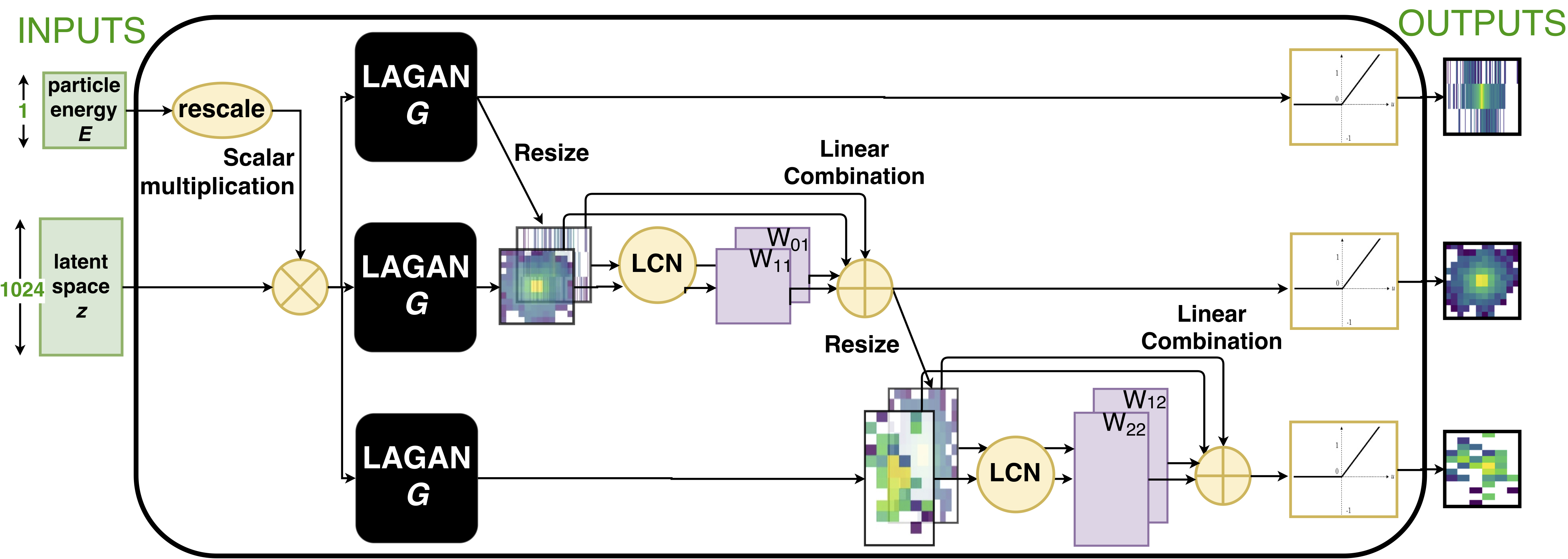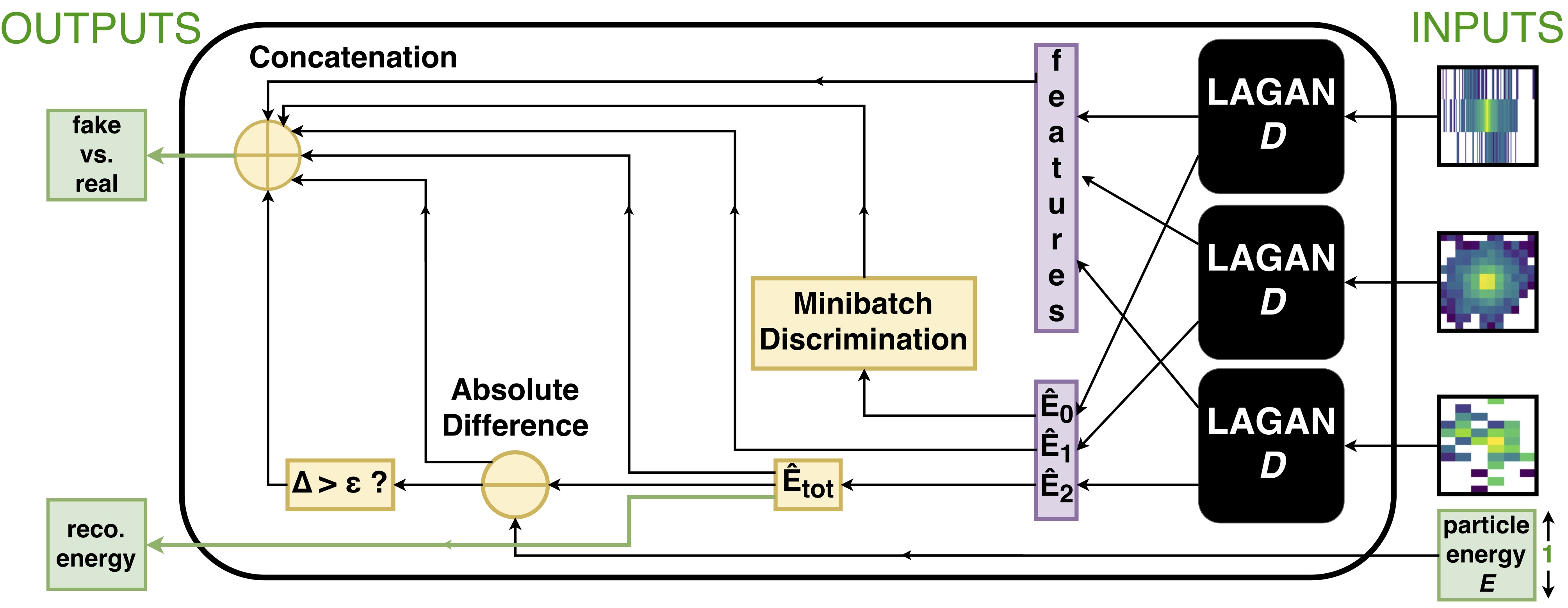hep-lbdl / Calogan
Projects that are alternatives of or similar to Calogan
CaloGAN
Simulating 3D High Energy Particle Showers in Multi-Layer Electromagnetic Calorimeters with Generative Adversarial Networks.
This repository contains what you'll need to reproduce M. Paganini (@mickypaganini), L. de Oliveira (@lukedeo), B. Nachman (@bnachman), CaloGAN: Simulating 3D High Energy Particle Showers in Multi-Layer Electromagnetic Calorimeters with Generative Adversarial Networks [arXiv:1705.02355].
You are more than welcome to use the open data and open-source software provided here for any of your projects, but we kindly ask you that you please cite them using the DOIs provided below:
| Asset | Location |
|---|---|
| Training Data (GEANT4 showers, ⟂ to center) | |
| Source Code (this repo!) |
For any use of paper ideas and results, please cite
@article{paganini_calogan,
author = "Paganini, Michela and de Oliveira, Luke and Nachman,
Benjamin",
title = "{CaloGAN: Simulating 3D High Energy Particle Showers in
Multi-Layer Electromagnetic Calorimeters with Generative
Adversarial Networks}",
year = "2017",
eprint = "1705.02355",
archivePrefix = "arXiv",
primaryClass = "hep-ex",
}
Goal
The goal of this project is to help physicists at CERN speed up their simulations by encoding the most computationally expensive portion of the simulation process (i.e., showering in the EM calorimeter) in a deep generative model.
The challenges come from the fact that this portion of the detector is longitudinally segmented into three layers with heterogeneous granularity. For simplicity, we can visualize the energy depositions of particles passing through the detector as a series of three images per shower, while keeping in mind the sequential nature of their relationship in the generator.
To download and better understand the training dataset, visit the Mendeley Data repository.
Getting Started
This repository contains three main folders: generation, models and analysis, which represent the three main stages in this project. You may decide to only engage in a subset of them, so we decided to provide you with all you need to jump right in at the level you are interested in.
generation contains the code to build the electromagnetic calorimeter geometry and shoot particles at it with a give energy. This is all based on Geant4. For more instructions, go to Generation on PDSF.
models contains the core ML code for this project. The file train.py takes care of loading the data and training the GAN.
analysis contains Jupyter Notebooks used to evaluate performance and produce all plots for the paper.
GEANT4 Generation on PDSF
On PDSF, your should run all generation code that outputs big files to a scratch space. To make a scratch environment, run mkdir /global/projecta/projectdirs/atlas/{your-username}, and for convenience, link to home via ln -s /global/projecta/projectdirs/atlas/{your-username} ~/scratch.
To build the generation code on PDSF, simply run source cfg/pdsf-env.sh from the generation/ folder in the repository. This loads modules.
Next, you can type make which should build an executable called generate. Because of how Geant4 works, this executable gets deposited in $HOME/geant4_workdir/bin/Linux-g++/, which is in your $PATH when the modules from cfg/pdsf-env.sh are loaded.
To run the generation script, run generate -m cfg/run2.mac. You can change generation parameters inside cfg/run2.mac (follow these instructions).
This will output a file called plz_work_kthxbai.root with a TTree named fancy_tree, which will contain a branch for each calorimeter cell (cell_#) with histograms of the energy deposited in that cell across the various shower events. The last three cells (numbered 504, 505, and 506) actually represent the overflow for each calorimeter layer. Finally, a branch called TotalEnergy is added for bookkeeping.
We provide you with a convenient script to convert the ROOT file into a more manageable HDF5 archive. The convert.py script is located in the generation/ folder and can be used as follows:
usage: convert.py [-h] --in-file IN_FILE --out-file OUT_FILE --tree TREE
Convert GEANT4 output files into ML-able HDF5 files
optional arguments:
-h, --help show this help message and exit
--in-file IN_FILE, -i IN_FILE
input ROOT file
--out-file OUT_FILE, -o OUT_FILE
output HDF5 file
--tree TREE, -t TREE input tree for the ROOT file
So you can run, for example, python convert.py --in-file plz_work_kthxbai.root --out-file test.h5 --tree fancy_tree.
Assuming you specified /run/beamOn 1000 in your run.mac file, the structure of the output HDF5 should look like this:
energy Dataset {1000, 1}
layer_0 Dataset {1000, 3, 96}
layer_1 Dataset {1000, 12, 12}
layer_2 Dataset {1000, 12, 6}
overflow Dataset {1000, 3}
To launch a batch job on PDSF, simply run ./launch <num_jobs>, to launch <num_jobs> concurrent tasks in a job array.
The CaloGAN Model
This work builds on the solution presented in arXiv/1701.05927 which we named LAGAN, or Location-Aware Generative Adversarial Network. This is a Physics specific modification of the more common DCGAN and ACGAN frameworks which is specifically designed to handle the levels of sparsity, the location dependence, and the high dynamic range that characterizes Physics images.
Generator
 The Generator contains three parallel LAGAN-style streams with an in-painting mechanism to handle the sequential nature of these shower images.
The Generator contains three parallel LAGAN-style streams with an in-painting mechanism to handle the sequential nature of these shower images.
Discriminator
 The discriminator uses convolutional features combined with ad-hoc notions of sparsity and reconstructed energy to classify real and fake images as well as comparing the reconstructred energy with the condition requested by the user.
The discriminator uses convolutional features combined with ad-hoc notions of sparsity and reconstructed energy to classify real and fake images as well as comparing the reconstructred energy with the condition requested by the user.
Training the CaloGAN model
To begin the training process, create a YAML file with the specification in models/particles.yaml for all the particles you want to train on. In the paper, we only train one GAN per particle type. If you specify more than one particle type and dataset in the YAML file, it will train an ACGAN, which we found to not be as performant. Assuming that you have a folder called data/ in the root directory of the project, and you have a file inside called eplus.h5 (downloaded from Mendeley, perhaps?), you can train your own CaloGAN by running
python -m models.train models/particles.yaml
We recommend running python -m models.train -h at least once to see all the parameters one can change.
Performance Analysis
Performance evaluation is done both from a qualitative and a quantitative standpoint. The jupyter notebook available in the analysis folder will guide you through our plotting conventions.
For quick handling, we have pre-extracted the shower shape variables into a pandas dataframe (stored as HDF5) and made it available available on S3. To load, you can simply do pd.read_hdf('path/to/shower-shapes.h5').
Docker
Running in local :
$ docker run -it --rm -v $PWD/CaloGAN:/home/CaloGAN engineren/calogan-docker python -m models.train models/particles.yaml
Running naf-ilc-gpu :
$ singularity pull docker://engineren/calogan-docker:latest
$ singularity instance start --bind data:/home/CaloGAN/data --nv calogan-docker_latest.sif caloGAN
$ singularity run instance://caloGAN python -m models.train models/particles.yaml
Copyright Notice
“CaloGAN” Copyright (c) 2017, The Regents of the University of California, through Lawrence Berkeley National Laboratory (subject to receipt of any required approvals from the U.S. Dept. of Energy). All rights reserved.
If you have questions about your rights to use or distribute this software, please contact Berkeley Lab's Innovation & Partnerships Office at [email protected].
NOTICE. This Software was developed under funding from the U.S. Department of Energy and the U.S. Government consequently retains certain rights. As such, the U.S. Government has been granted for itself and others acting on its behalf a paid-up, nonexclusive, irrevocable, worldwide license in the Software to reproduce, distribute copies to the public, prepare derivative works, and perform publicly and display publicly, and to permit other to do so.

